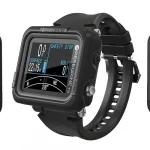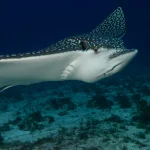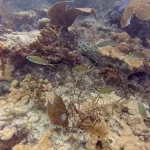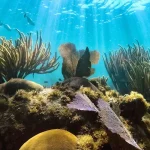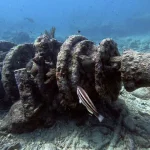Table of Contents
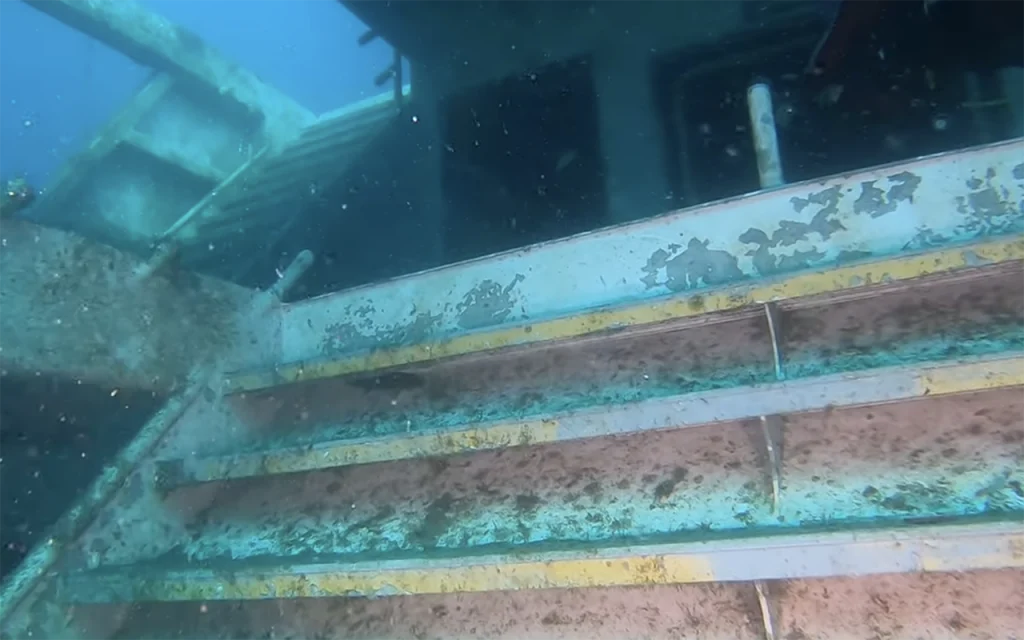
Overall, the El Dorado seems to be a popular and rapidly evolving dive site, offering divers a chance to explore a relatively new wreck that’s quickly becoming home to diverse marine life.
Article at a Glance
- Historical Significance: Originally built in 1993 as the Sun Dancer, the El Dorado served as a luxury cruise liner and casino ship before its transformation into an artificial reef.
- Hurricane Resilience: The ship was washed ashore during Hurricane Ivan in 2004 and later during Hurricane Michael in 2018, which ultimately led to its sinking as an artificial reef.
- Artificial Reef Creation: On May 3, 2019, the El Dorado was intentionally sunk off the coast of Panama City, Florida, to create a new dive site and habitat for marine life.
- Diverse Marine Ecosystem: Since its sinking, the wreck has quickly attracted a variety of marine species, including sandbar sharks, goliath grouper, and schools of mackerel, making it a vibrant dive location.
- Diving Accessibility: The wreck is located 12 nautical miles south of St. Andrew Bay Pass at a depth of 103 feet, with the top of the wreck accessible at about 62 feet, suitable for advanced divers.
- Unique Features: Divers can still identify structural elements of the ship, including remnants of its former luxury design and the once-visible “Happy Holidays” message painted on the deck.
- Local Dive Opportunities: Several dive shops in Panama City Beach, such as Diver’s Den and Panama City Diving, offer guided trips to explore the El Dorado, providing divers with a safe and exciting underwater experience.
Shipwreck Location Coordinates and Depth
Depth
The El Dorado rests at a depth of 103 feet (31.4 meters).
Location Coordinates
The El Dorado shipwreck is located at the following coordinates: 29° 58.9164′ N, 085° 50.9502′ W
What Do Scuba Divers Say About This Ship
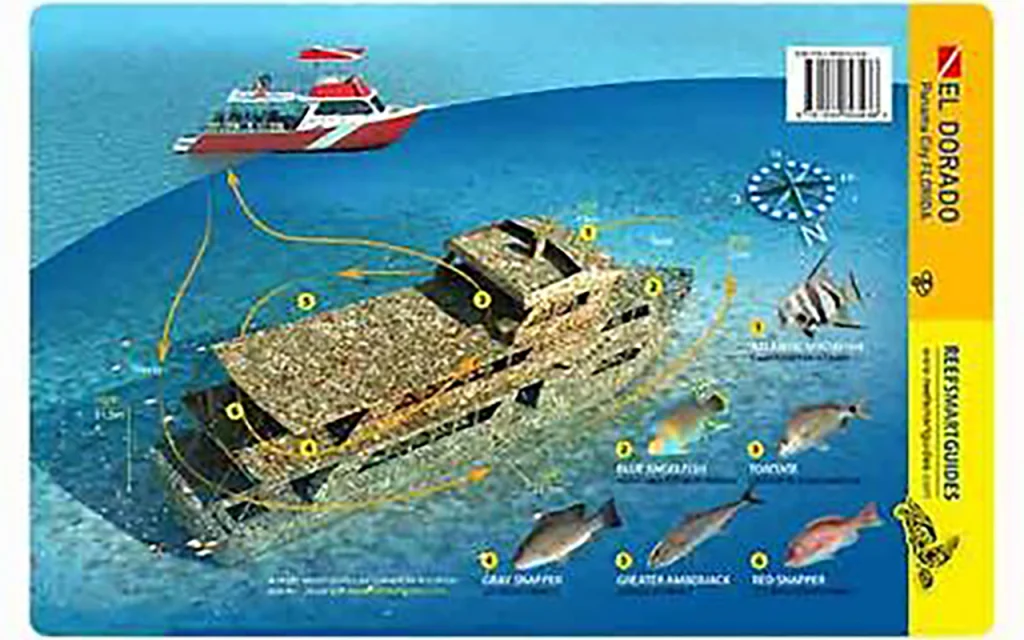
What Do Scuba Divers Say About This Ship
Dive Experience
Divers who have explored the El Dorado report a unique and interesting experience:
- The wreck is described as remarkably clean, with the dark-green water contrasting against the stark white of the ship’s hull.
- The top of the wreck sits at about 62 feet below the surface, making it accessible for advanced divers.
Marine Life
The El Dorado has quickly become a thriving artificial reef:
- Divers have observed significant aquatic life growth since the ship’s sinking.
- Marine life includes schooling mackerel swarming the stern and back deck.
- Sandbar sharks and resident goliath grouper have been spotted at the site.
- Schools of baitfish are often seen intertwining around the wreck.
Unique Features
The wreck offers some interesting points of interest for divers:
- Initially, the phrase “Happy Holidays” was visible on the deck, providing a fun photo opportunity for divers.
- However, as of October (likely 2019), this greeting was no longer visible due to new growth on the wreck.
Diving Conditions
Divers should be aware of the following conditions:
- The Gulf of Mexico can be unpredictable, and dive conditions vary drastically by season.
- Water temperature ranges from high 50s in winter to mid-80s during summer.
- Visibility can reach over 100 feet on a good day, but averages between 30 to 60 feet.
What Kind of Marine Life Can Be Found on The Ship
Fish Species
- Sandbar sharks
- Goliath grouper
- Schooling mackerel
- Schools of baitfish
Marine Growth
- Significant aquatic life growth has been observed on the wreck since its sinking in 2019.
- By October 2019, new growth had already covered some features of the ship, such as the “Happy Holidays” message that was initially visible on the deck.
Ecosystem Development
The El Dorado has quickly become a thriving artificial reef:
- The wreck provides structure and habitat for various marine species.
- Schools of fish can be seen intertwining around the wreck, creating what one diver described as a “fishy jazz performance”.
Seasonal Variations
It’s worth noting that marine life observations may vary depending on the season and diving conditions. The Gulf of Mexico can be unpredictable, with water temperatures ranging from the high 50s in winter to mid-80s in summer.
Key Information
| Characteristic | Details |
|---|---|
| Original Name | Sun Dancer |
| Year Built | 1993 |
| Type of Vessel | Triple deck aluminum dining and gambling ship |
| Length | 157 feet |
| Beam | 28 feet |
| Passenger Capacity | 320 |
| Sinking Date | May 3, 2019 |
| Depth | 103 feet (top at 62 feet) |
| Location Coordinates | 29° 58.9164′ N, 085° 50.9502′ W |
| Distance from Shore | 12 nautical miles south of St. Andrew Bay Pass |
| Notable Events | – Washed ashore during Hurricane Ivan (2004) |
| – Transferred to Millville waterfront (2011) | |
| – Washed ashore again during Hurricane Michael (2018) | |
| Marine Life Observed | Sandbar sharks, goliath grouper, schooling mackerel, baitfish |
| Diving Conditions | – Water temp: High 50s (winter) to mid-80s (summer) |
| – Visibility: 30 to 60 feet on average, up to 100+ feet on good days | |
| Recommended Wetsuit | 3mm to 7mm |
| Best Time to Dive | Year-round |
What Makes The El Dorado Shipwreck a Unique Diving Experience
Recent Artificial Reef
- The El Dorado was sunk as an artificial reef relatively recently, on May 3, 2019.
- This means divers can explore a “clean” wreck that is still in the early stages of becoming an artificial reef.
Rapid Marine Life Development
- Despite being a new wreck, the El Dorado has quickly attracted diverse marine life.
- Divers have reported significant aquatic life growth since its sinking, including:
- Sandbar sharks
- Resident goliath grouper
- Schooling mackerel
- Schools of baitfish
Interesting History
- The ship has a unique backstory, having been washed ashore twice by hurricanes before being intentionally sunk.
- It transitioned from a luxury cruise liner to a casino ship before becoming an artificial reef.
Diving Conditions
- The wreck sits at 103 feet deep, with its top at about 62 feet below the surface.
- This depth range makes it accessible for advanced divers while still providing a challenging dive.
Evolving Dive Site
- The wreck is in a state of constant change as marine life colonizes it.
- Initially, divers could see “Happy Holidays” painted on the deck, but by October 2019, this was no longer visible due to new growth.
Location
- The El Dorado is part of Panama City Beach’s extensive artificial reef system, which includes over 50 sites.
- Its location in the Gulf of Mexico offers varying diving conditions throughout the year, providing different experiences depending on when divers visit.
How Does The El Dorado Compare to Other Shipwrecks in Florida
Recent Addition
- The El Dorado was sunk as an artificial reef in 2019, making it one of the newest shipwrecks available for diving in Florida.
- This recent sinking means divers can observe the early stages of marine life colonization and reef development.
Modern Vessel
- Unlike many older military or cargo ships, the El Dorado was a modern 157-foot luxury cruise liner and casino ship.
- This provides divers with a different architectural style and layout compared to more traditional shipwrecks.
Hurricane History
- The El Dorado has a unique backstory, having been washed ashore twice by hurricanes (Ivan in 2004 and Michael in 2018) before being intentionally sunk.
- This history connects the wreck to Florida’s experiences with major hurricanes, adding an interesting narrative element.
Rapid Ecosystem Development
- Despite being a new wreck, the El Dorado has quickly attracted diverse marine life, including sandbar sharks, goliath grouper, and schools of mackerel.
- This rapid colonization offers divers a chance to witness the evolution of an artificial reef ecosystem in its early stages.
Accessibility
- The wreck sits at 103 feet deep, with its top at about 62 feet below the surface.
- This depth range makes it accessible for advanced divers while still providing a challenging dive, unlike some deeper wrecks that may be out of reach for recreational divers.
What is The Full History of This Ship
Early History
- The El Dorado was originally built in 1993 as a triple-deck aluminum dining and gambling ship.
- It was previously called the Sun Dancer and was registered in Boston, Massachusetts.
- The vessel served as a luxury cruise liner and later as a casino ship.
- It was certified to carry 320 passengers.
Hurricane Ivan (2004)
- The El Dorado was washed ashore in Panama City during Hurricane Ivan in 2004.
Attempted Restoration
- Marine salvor Lee Ingram, a Panama City native, purchased the ship with intentions to restore it and put it back into service.
- In 2011, the ship was transferred from St. Andrews Marina to the Millville waterfront.
Hurricane Michael (2018)
- In October 2018, Hurricane Michael struck the Florida Panhandle.
- The storm broke El Dorado loose from its moorings in St. Andrews Bay.
- It was pushed ashore near the Florida State University Panama City campus, near the Hathaway Bridge.
- For months, the overturned ship was visible to travelers crossing the Hathaway Bridge.
- Someone painted “Happy Holidays” on the deck during the Christmas season.
Artificial Reef Project
- After Hurricane Michael, the ship became a candidate for an artificial reef project.
- The Florida Fish and Wildlife Conservation Commission (FWC) derelict vessel program assisted in raising the ship.
- It was towed to St. Andrews Marina in downtown Panama City, where Bay County took possession of it.
- Lee Ingram donated the vessel to be used as an artificial reef.
Preparation and Sinking
- The ship underwent a cleaning process to remove all hazardous materials and floatables.
- This preparation took about seven months from the storm to sinking.
- On May 3, 2019, the El Dorado was finally sunk as an artificial reef.
Current Status
- The El Dorado now rests 12 nautical miles south of St. Andrew Bay Pass.
- It sits at a depth of 103 feet, with its top at about 62 feet below the surface.
- The wreck’s coordinates are 29° 58.9164′ N, 085° 50.9502′ W.
- It has quickly become home to diverse marine life, including sandbar sharks, goliath grouper, schooling mackerel, and various other fish species.
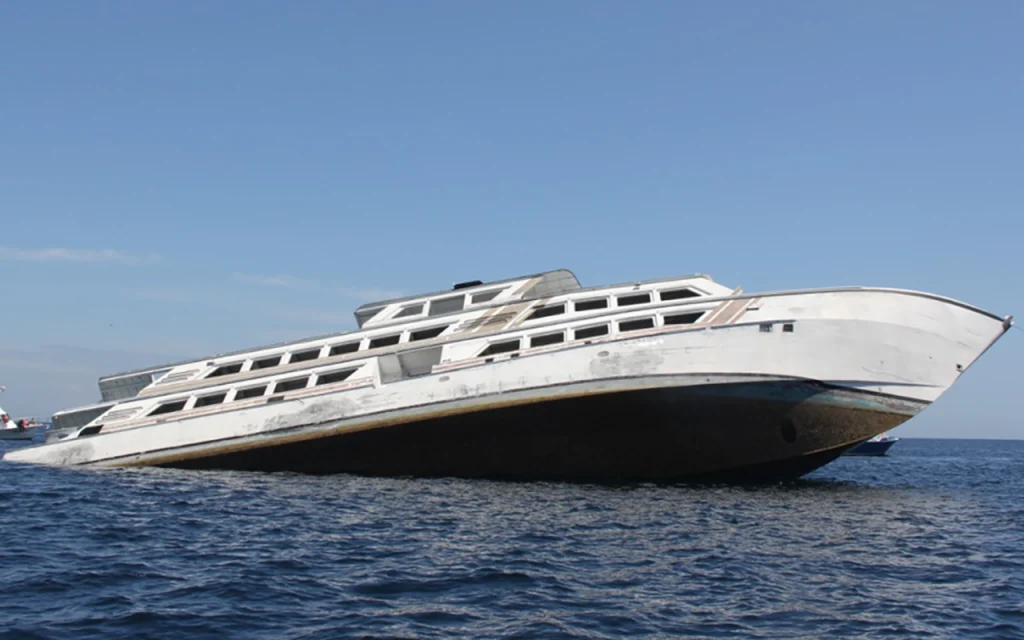
What Historical Features Can Still Be Identified on the El Dorado Wreck
- Overall structure: The El Dorado was a 157-foot long triple-deck aluminum vessel, originally built as a dining and gambling ship. Divers may still be able to identify the general layout and deck structures of the ship.
- “Happy Holidays” message: Shortly after the ship was washed ashore by Hurricane Michael in 2018, someone painted “Happy Holidays” on the deck. This message was visible to early divers after the ship was sunk as an artificial reef in May 2019. However, by October 2019, this message was no longer visible due to new marine growth.
- Architectural elements: As a former luxury cruise liner and casino ship, the El Dorado likely had distinctive architectural features that may still be identifiable, such as dining areas, gambling rooms, or passenger cabins.
- Aluminum construction: The ship’s aluminum construction may still be evident in parts of the wreck that are less covered by marine growth.
- Stern and back deck: Early dive reports mentioned schooling mackerel swarming these areas, suggesting these parts of the ship structure were still clearly identifiable.
What Safety Measures Are in Place for Divers Visiting the El Dorado
- Depth considerations: The El Dorado rests at 103 feet deep, with its top at about 62 feet below the surface. This depth range makes it suitable for advanced divers, ensuring that only experienced divers attempt to explore the wreck.
- Artificial reef preparation: Before sinking, the ship underwent a thorough cleaning process to remove all hazardous materials and floatables, making it safer for divers to explore.
- Mooring line: There is mention of a mooring line, which provides a safe and controlled descent and ascent point for divers.
- Local dive operators: Reputable local dive operators, such as Diver’s Den mentioned in the search results, conduct guided dives to the wreck. These operators typically enforce safety standards and provide briefings on dive conditions.
- Seasonal considerations: Dive operators are aware that conditions in the Gulf of Mexico can be unpredictable and vary drastically by season. They likely advise divers on the best times to visit and current conditions.
- Equipment recommendations: Based on the water temperature range (high 50s in winter to mid-80s in summer), appropriate wetsuit recommendations (3mm to 7mm) are provided to ensure thermal protection.
- Visibility awareness: Divers are informed about the average visibility conditions, which can range from 30 to 60 feet, with potential for 100+ feet on good days. This helps divers prepare for the conditions they might encounter.
Dive Shops That Provide Diving Trips to This Shipwreck
- Diver’s Den
- This local operator was specifically mentioned as conducting one of the first dives to the El Dorado after it was sunk.
- Panama City Diving
- This dive shop offers offshore wreck diving trips that include the El Dorado among other wrecks.
- Atlantic Scuba
- While not directly linked to El Dorado trips, this shop is run by Mark Milburn, who is mentioned as a local technical diver familiar with the area’s wrecks.
North Florida Wrecks
- USS Oriskany
- USS Massachusetts
- SS Tarpon
- SS Gulf America
- Empire Mica
- USS Chippewa
- Avocet
- Black Bart
- The Vamar
- San Pablo
- USS Narcissus
- The Loftus Wreck
- The Dorothy Louise
- The Mizpah
- MV Janet
- The Eidsvag
- YDT-14 and YDT-15
- USS Strength
- Miss Louise
- The Lulu
- PC-1174
- Three Coal Barges
- USS Accokeek (ATA-181)
- El Dorado
- The Grey Ghost
- The Pete Tide II
- Red Sea Tug

